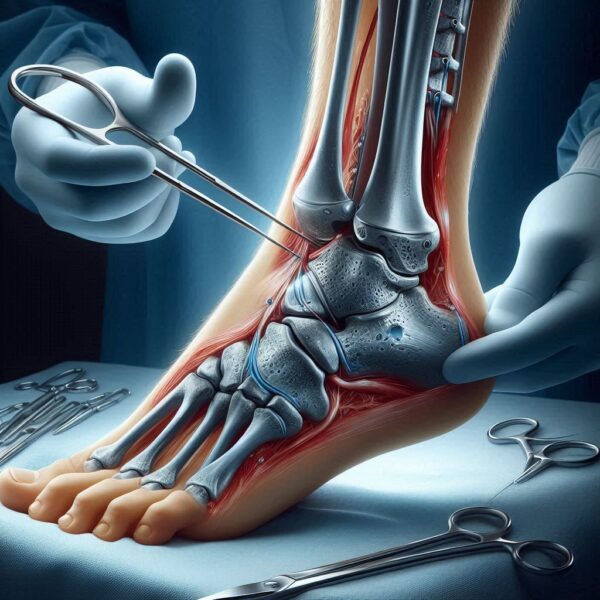

From: 100.00$
The Iran Health Clinic is a reputable medical center that specializes in providing advanced fat transfer treatment to its patients. With a team of experienced doctors who have been trained in the latest fat transfer techniques, the clinic is committed to delivering high-quality care that is tailored to meet the unique needs of each patient.
Using state-of-the-art technology and equipment, the clinic can perform fat transfer procedures that are safe, effective, and minimally invasive. Whether you are looking to restore volume to your face, increase the size of your breasts, or enhance your buttocks, the Iran Health Clinic can help you achieve your desired results.
With a warm and welcoming environment, the clinic strives to make every patient feel comfortable and relaxed throughout their entire treatment process. If you are looking for a trusted medical center for your fat transfer needs, then the Iran Health Clinic is the right choice for you.
Ankle fusion surgery, also known as ankle arthrodesis, is a common surgical procedure for treating end-stage ankle arthritis. It is the gold-standard surgical treatment for individuals who do not respond to conservative treatments. This procedure aims to address chronic pain and loss of function caused by severe ankle arthritis, ultimately improving the patient’s quality of life 1
During ankle fusion surgery, the surgeon accesses the ankle joint and may use tools to remove remaining cartilage and prepare the joint surface for fusion. Screws or screws and plates may be utilized to hold the ankle in the correct position. In some cases, a bone graft may be used to aid in fusion, which can be taken from the pelvis, heel bone, or just below the knee. The procedure may also be performed through a minimally invasive technique known as arthroscopic surgery. After the surgery, the patient receives a wide cast covered by a gauze dressing, and post-operative swelling may occur. The initial cast is typically changed to a second cast at two weeks postoperative 2
Ankle fusion surgery is suitable for individuals with end-stage ankle arthritis who have not responded to conservative treatments. Those experiencing chronic pain and loss of function due to severe ankle arthritis may benefit from this procedure. Ankle fusion aims to provide relief and improve the overall function of the affected ankle, allowing individuals to regain mobility and enhance their quality of life 1
Ankle fusion surgery may not be suitable for individuals with certain medical conditions that increase the risks associated with surgery. Additionally, those with less severe ankle arthritis that can be effectively managed through non-surgical treatments may not be suitable candidates for this procedure.
The advantages of ankle fusion surgery include the potential for pain relief and improved function in the affected ankle. By addressing end-stage ankle arthritis, the surgery aims to enhance mobility and overall quality of life for suitable candidates 1
Complications associated with ankle fusion surgery may include the risk of infection, nerve damage, delayed healing, and the potential need for repeat surgery in cases of nonunion. Improper positioning during the procedure can strain adjacent joints, leading to pain and degeneration, which may necessitate additional fusion surgery. Some shortening of approximately 1 to 2 cm usually results from the procedure 3
Preoperative care for ankle fusion surgery involves patient education to increase familiarity with the procedure and decrease anxiety. It also includes instructions on activities that promote healing and prevent postoperative complications. Additionally, preoperative X-rays are used to describe ankle fracture patterns following anatomic classification, aiding in the planning of the surgical approach 4
Postoperative care for ankle fusion surgery focuses on monitoring the patient’s physiological health and aiding in postsurgical recovery. This phase may involve rehabilitation and recuperation, including the use of a walking boot and a gradual return to weight-bearing activities after a specified period. Continuing cryotherapy treatment may also be recommended if swelling is still apparent 2
Only logged in customers who have purchased this product may leave a review.
Ankle fusion surgery, also known as ankle arthrodesis, is a common surgical procedure for treating end-stage ankle arthritis. It is the gold-standard surgical treatment for individuals who do not respond to conservative treatments. This procedure aims to address chronic pain and loss of function caused by severe ankle arthritis, ultimately improving the patient’s quality of life 1
During ankle fusion surgery, the surgeon accesses the ankle joint and may use tools to remove remaining cartilage and prepare the joint surface for fusion. Screws or screws and plates may be utilized to hold the ankle in the correct position. In some cases, a bone graft may be used to aid in fusion, which can be taken from the pelvis, heel bone, or just below the knee. The procedure may also be performed through a minimally invasive technique known as arthroscopic surgery. After the surgery, the patient receives a wide cast covered by a gauze dressing, and post-operative swelling may occur. The initial cast is typically changed to a second cast at two weeks postoperative 2
Ankle fusion surgery is suitable for individuals with end-stage ankle arthritis who have not responded to conservative treatments. Those experiencing chronic pain and loss of function due to severe ankle arthritis may benefit from this procedure. Ankle fusion aims to provide relief and improve the overall function of the affected ankle, allowing individuals to regain mobility and enhance their quality of life 1
Ankle fusion surgery may not be suitable for individuals with certain medical conditions that increase the risks associated with surgery. Additionally, those with less severe ankle arthritis that can be effectively managed through non-surgical treatments may not be suitable candidates for this procedure.
The advantages of ankle fusion surgery include the potential for pain relief and improved function in the affected ankle. By addressing end-stage ankle arthritis, the surgery aims to enhance mobility and overall quality of life for suitable candidates 1
Complications associated with ankle fusion surgery may include the risk of infection, nerve damage, delayed healing, and the potential need for repeat surgery in cases of nonunion. Improper positioning during the procedure can strain adjacent joints, leading to pain and degeneration, which may necessitate additional fusion surgery. Some shortening of approximately 1 to 2 cm usually results from the procedure 3
Preoperative care for ankle fusion surgery involves patient education to increase familiarity with the procedure and decrease anxiety. It also includes instructions on activities that promote healing and prevent postoperative complications. Additionally, preoperative X-rays are used to describe ankle fracture patterns following anatomic classification, aiding in the planning of the surgical approach 4
Postoperative care for ankle fusion surgery focuses on monitoring the patient’s physiological health and aiding in postsurgical recovery. This phase may involve rehabilitation and recuperation, including the use of a walking boot and a gradual return to weight-bearing activities after a specified period. Continuing cryotherapy treatment may also be recommended if swelling is still apparent 2
There are no reviews yet.
Only logged in customers who have purchased this product may leave a review.
Choosing the right hospital and physician are important factors to consider that significantly influence a patient’s treatment. The preferred choice for many patients is choosing private care.
Choosing the right hospital and physician are important factors to consider that significantly influence a patient’s treatment.
Reviews
There are no reviews yet.